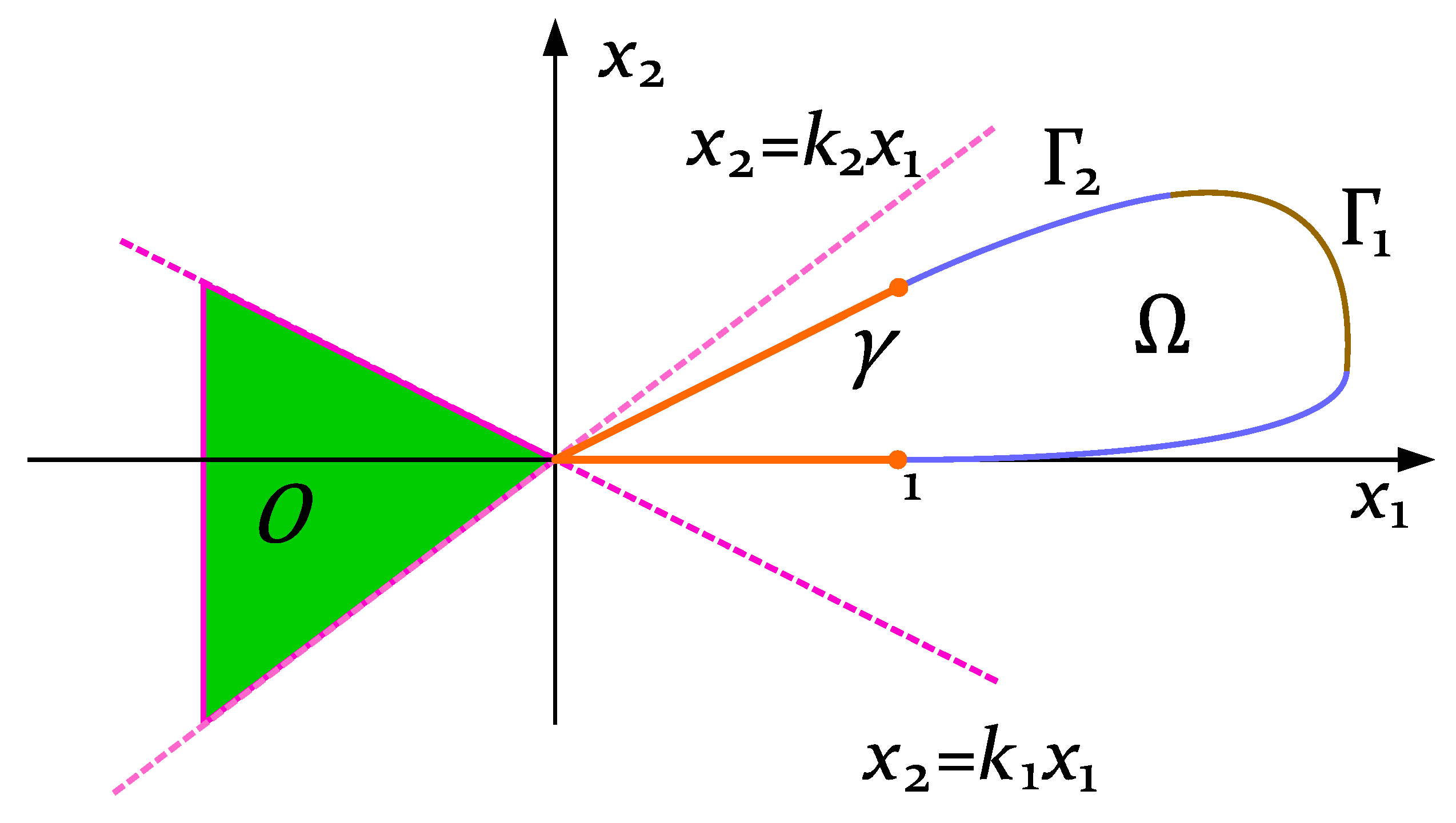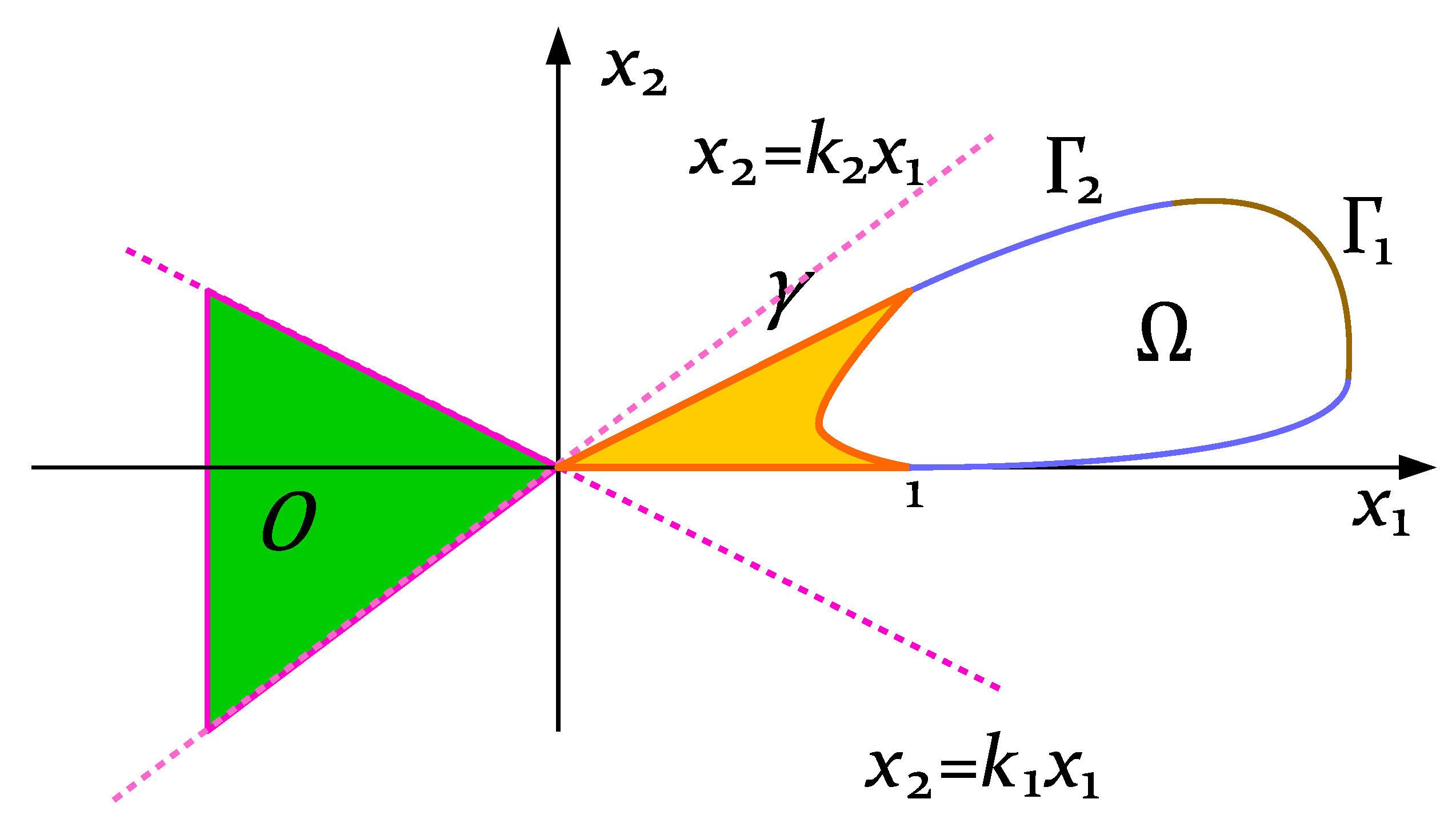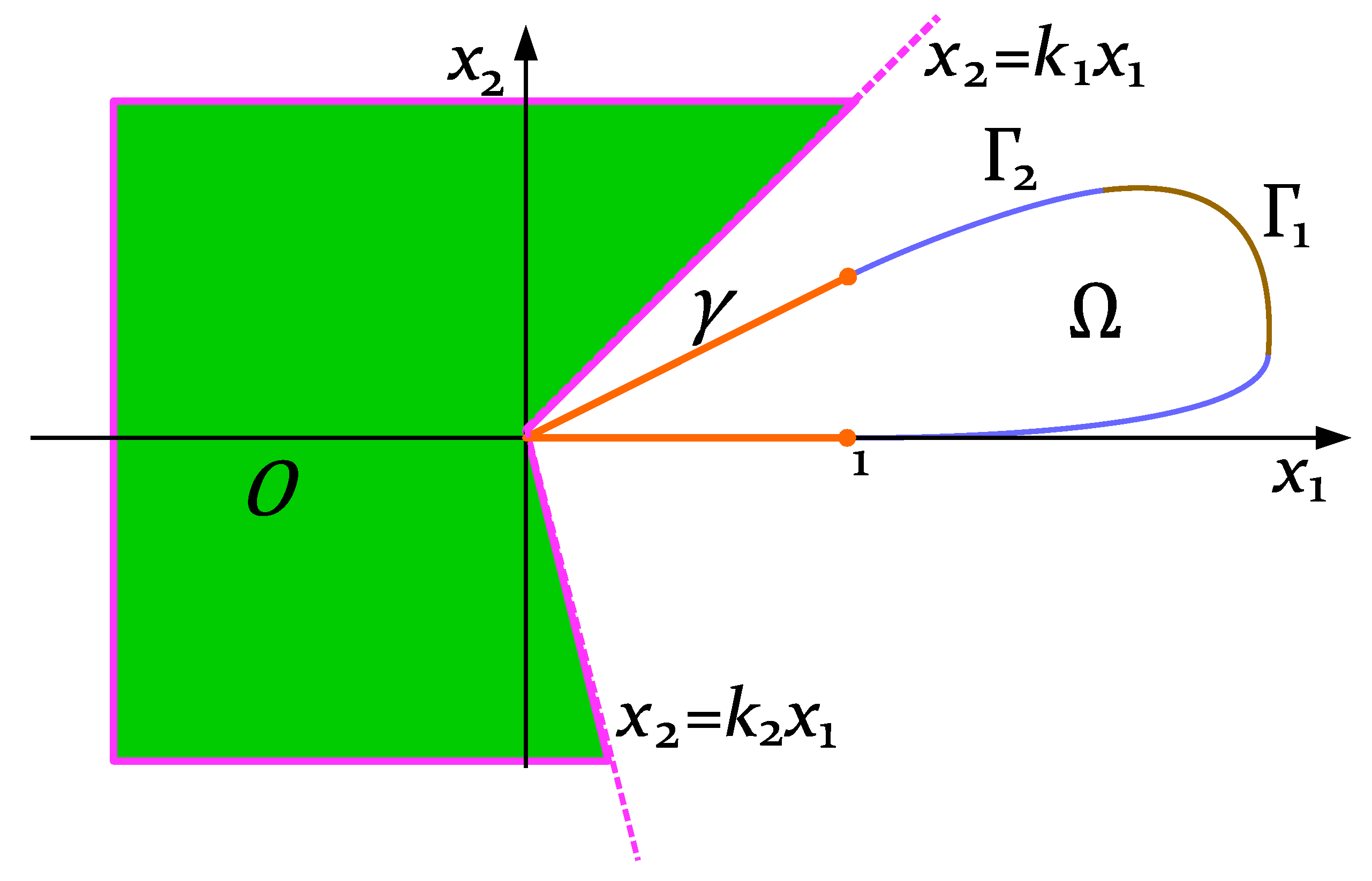Signorini-Type Problems over Non-Convex Sets for Composite Bodies Contacting by Sharp Edges of Rigid Inclusions
Abstract
1. Introduction
2. The Case of a Thin Rigid Inclusion
3. The Case of a Volume Rigid Inclusion
4. The Case of Two-Hinged Thin Rigid Inclusions
5. The Case of an Obstacle with an Obtuse Angle and a Body with Sharp-Shaped Edge
6. Discussion
Author Contributions
Funding
Institutional Review Board Statement
Informed Consent Statement
Data Availability Statement
Conflicts of Interest
References
- Fichera, G. Boundary Value Problems of Elasticity with Unilateral Constraints. In Handbook der Physik, Band 6a/2; Springer: Berlin/Heidelberg, Germany; New York, NY, USA, 1972. [Google Scholar]
- Rademacher, A.; Rosin, K. Adaptive optimal control of Signorini’s problem. Comput. Optim. Appl. 2018, 70, 531–569. [Google Scholar] [CrossRef]
- Bermúdez, A.; Saguez, C. Optimal control of a Signorini problem. SIAM J. Control Optim. 1987, 25, 576–582. [Google Scholar] [CrossRef]
- Schumann, R. Regularity for Signorini’s problem in linear elasticity. Manuscripta Math. 1989, 63, 255–291. [Google Scholar] [CrossRef]
- Kinderlehrer, D. Remarks about Signorini’s problem in linear elasticity. Ann. Sc. Norm. Super. Pisa 1981, 8, 605–645. [Google Scholar]
- Hintermüller, M.; Kovtunenko, V.A.; Kunisch, K. Obstacle problems with cohesion: A hemivariational inequality approach and its efficient numerical solution. SIAM J. Optim. 2011, 21, 491–516. [Google Scholar] [CrossRef][Green Version]
- De Benito Delgado, M.; Díaz, J.I. Some remarks on the coincidence set for the Signorini problem. Opusc. Math. 2019, 39, 145–157. [Google Scholar] [CrossRef]
- Pyatkina, E.V. A contact of two elastic plates connected along a thin rigid inclusion. Sib. Electron. Math. Rep. 2020, 17, 1797–1815. [Google Scholar] [CrossRef]
- Rudoi, E.M.; Khludnev, A.M. Unilateral contact of a plate with a thin elastic obstacle. J. Appl. Ind. Math. 2010, 4, 389–398. [Google Scholar] [CrossRef]
- Kovtunenko, V.A. Primal-dual sensitivity analysis of active sets for mixed boundary-value contact problems. J. Eng. Math. 2006, 55, 147–162. [Google Scholar] [CrossRef]
- Khludnev, A.M.; Sokolowski, J. Modelling and Control in Solid Mechanics; Birkhauser: Basel, Switzerland; Boston, MA, USA; Berlin, Germany, 1997. [Google Scholar]
- Kikuchi, N.; Oden, J.T. Contact Problems in Elasticity: Study of Variational Inequalities and Finite Element Methods; SIAM: Philadelphia, PA, USA, 1988. [Google Scholar]
- Andersson, L.-E.; Klarbring, A.A. Review of the theory of elastic and quasistatic contact problems in elasticity. Phil. Trans. R. Soc. Lond. Ser. A 2001, 359, 2519–2539. [Google Scholar] [CrossRef]
- Khludnev, A.M. Elasticity Problems in Nonsmooth Domain; Fizmatlit: Moscow, Russia, 2010. [Google Scholar]
- Khludnev, A.M.; Kovtunenko, V.A. Analysis of Cracks in Solids; WIT-Press: Southampton, UK; Boston, MA, USA, 2000. [Google Scholar]
- Khludnev, A. Contact problems for elastic bodies with rigid inclusions. Q. Appl. Math. 2012, 70, 269–284. [Google Scholar] [CrossRef]
- Furtsev, A.; Itou, H.; Rudoy, E. Modeling of bonded elastic structures by a variational method: Theoretical analysis and numerical simulation. Int. J. Solids Struct. 2020, 182–183, 100–111. [Google Scholar] [CrossRef]
- Rudoy, E.M.; Shcherbakov, V.V. Domain decomposition method for a membrane with a delaminated thin rigid inclusion. Sib. Electron. Math. Rep. 2016, 13, 395–410. [Google Scholar]
- Knees, D.; Schröder, A. Global spatial regularity for elasticity models with cracks, contact and other nonsmooth constraints. Math. Methods Appl. Sci. 2012, 35, 1859–1884. [Google Scholar] [CrossRef]
- Khludnev, A.M. Shape control of thin rigid inclusions and cracks in elastic bodies. Arch. Appl. Mech. 2013, 83, 1493–1509. [Google Scholar] [CrossRef]
- Khludnev, A.M. Optimal control of crack growth in elastic body with inclusions. Eur. J. Mech. A. Solids. 2010, 29, 392–399. [Google Scholar] [CrossRef]
- Lazarev, N.P.; Semenova, G.M. Equilibrium problem for a Timoshenko plate with a geometrically nonlinear condition of nonpenetration for a vertical crack. J. Appl. Ind. Math. 2020, 14, 532–540. [Google Scholar] [CrossRef]
- Itou, H.; Kovtunenko, V.A.; Rajagopal, K.R. Nonlinear elasticity with limiting small strain for cracks subject to non-penetration. Math. Mech. Solids 2017, 22, 1334–1346. [Google Scholar] [CrossRef]
- Itou, H.; Kovtunenko, V.A.; Rajagopal, K.R. Well-posedness of the problem of non-penetrating cracks in elastic bodies whose material moduli depend on the mean normal stress. Int. J. Eng. Sci. 2019, 136, 17–25. [Google Scholar] [CrossRef]
- Khludnev, A. T-shape inclusion in elastic body with a damage parameter. J. Comput. Appl. Math. 2021, 393, 113540. [Google Scholar] [CrossRef]
- Khludnev, A.; Fankina, I. Equilibrium problem for elastic plate with thin rigid inclusion crossing an external boundary. Z. Angew. Math. Phys. 2021, 72, 121. [Google Scholar] [CrossRef]
- Stepanov, V.D.; Khludnev, A.M. The fictitious domain method as applied to the Signorini problem. Dokl. Math. 2003, 68, 163–166. [Google Scholar]
- Lazarev, N.P.; Everstov, V.V.; Romanova, N.A. Fictitious domain method for equilibrium problems of the Kirchhoff-Love plates with nonpenetration conditions for known configurations of plate edges. J. Sib. Fed. Univ. Math. Phys. 2019, 12, 674–686. [Google Scholar] [CrossRef]
- Lazarev, N.P.; Itou, H.; Neustroeva, N.V. Fictitious domain method for an equilibrium problem of the Timoshenko-type plate with a crack crossing the external boundary at zero angle. Jpn. J. Indust. Appl. Math. 2016, 33, 63–80. [Google Scholar] [CrossRef]
- Shcherbakov, V. Shape optimization of rigid inclusions for elastic plates with cracks. Z. Angew. Math. Phys. 2016, 67, 71. [Google Scholar] [CrossRef]



Publisher’s Note: MDPI stays neutral with regard to jurisdictional claims in published maps and institutional affiliations. |
© 2022 by the authors. Licensee MDPI, Basel, Switzerland. This article is an open access article distributed under the terms and conditions of the Creative Commons Attribution (CC BY) license (https://creativecommons.org/licenses/by/4.0/).
Share and Cite
Lazarev, N.P.; Kovtunenko, V.A. Signorini-Type Problems over Non-Convex Sets for Composite Bodies Contacting by Sharp Edges of Rigid Inclusions. Mathematics 2022, 10, 250. https://doi.org/10.3390/math10020250
Lazarev NP, Kovtunenko VA. Signorini-Type Problems over Non-Convex Sets for Composite Bodies Contacting by Sharp Edges of Rigid Inclusions. Mathematics. 2022; 10(2):250. https://doi.org/10.3390/math10020250
Chicago/Turabian StyleLazarev, Nyurgun P., and Victor A. Kovtunenko. 2022. "Signorini-Type Problems over Non-Convex Sets for Composite Bodies Contacting by Sharp Edges of Rigid Inclusions" Mathematics 10, no. 2: 250. https://doi.org/10.3390/math10020250
APA StyleLazarev, N. P., & Kovtunenko, V. A. (2022). Signorini-Type Problems over Non-Convex Sets for Composite Bodies Contacting by Sharp Edges of Rigid Inclusions. Mathematics, 10(2), 250. https://doi.org/10.3390/math10020250






